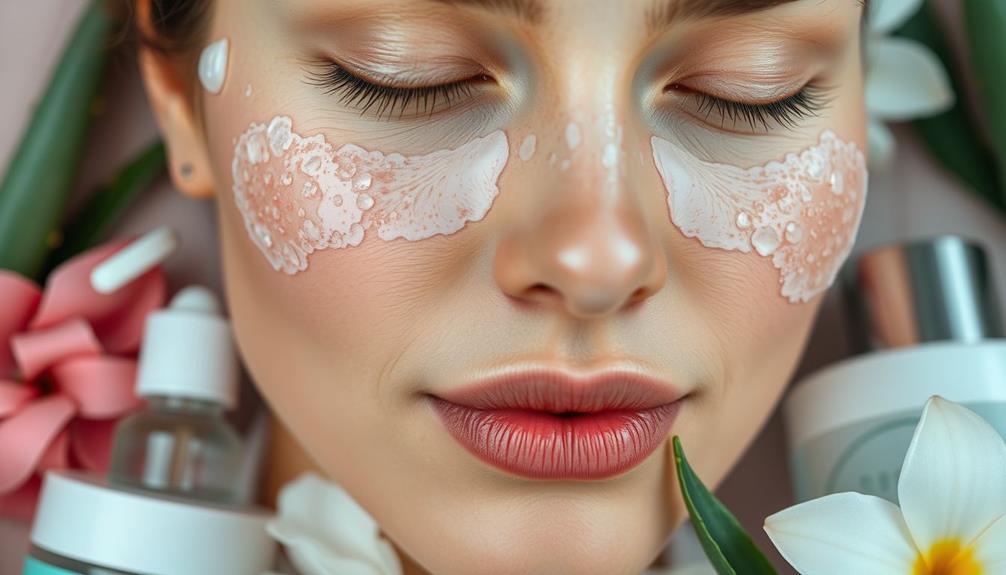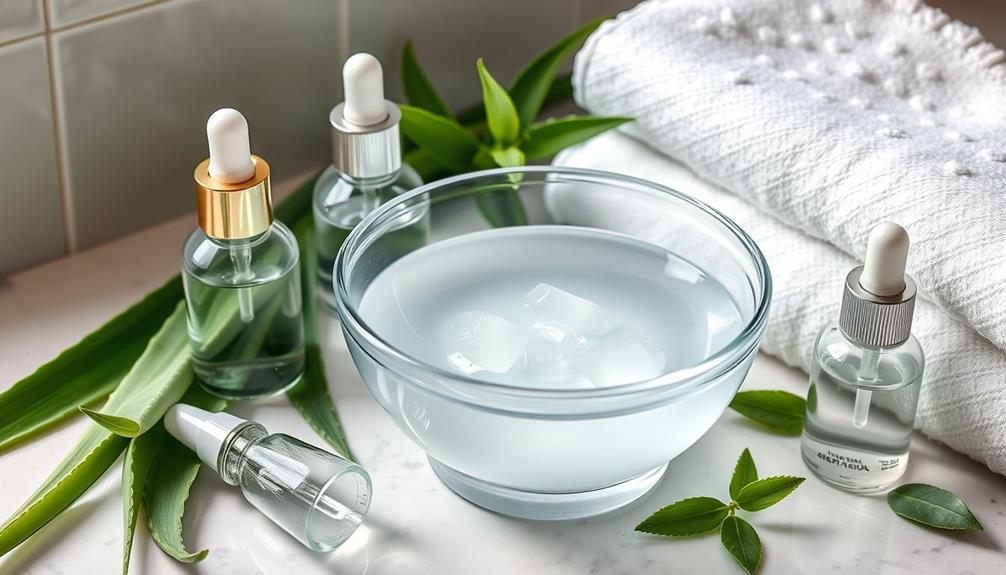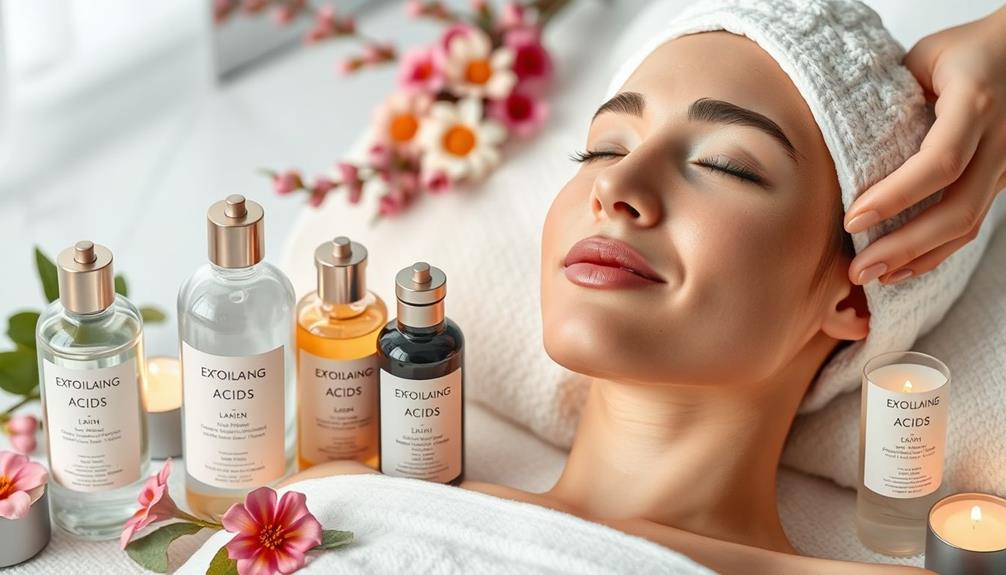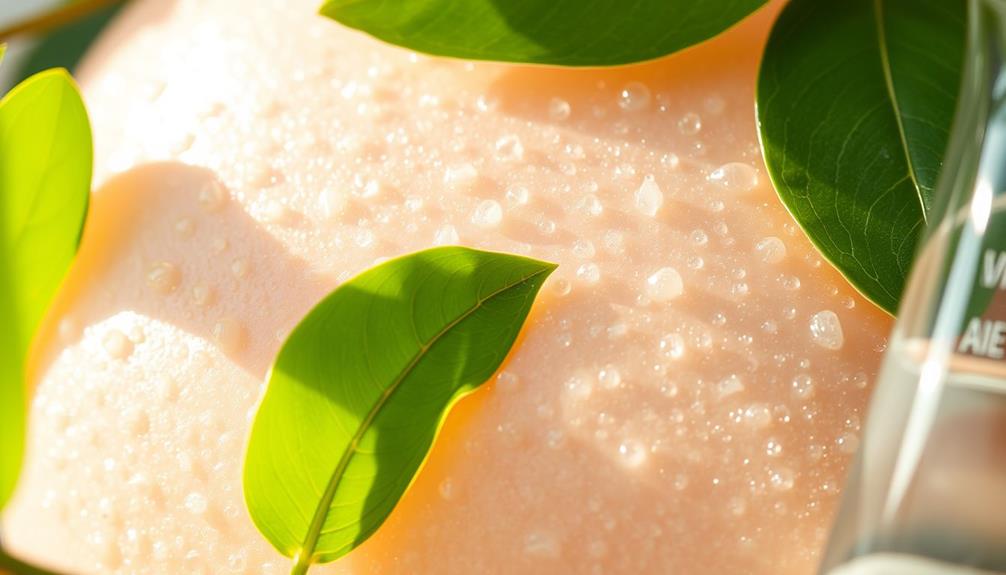Glycolic acid is a potent exfoliant that can transform your complexion by unveiling a luminous, glowing appearance. By eliminating dead skin cells, it uncovers newer skin layers and refines your skin’s texture. Consistent use can help diminish dark spots, smooth out fine lines, and reduce acne breakouts. To begin, start with gentle concentrations, applying it in the evening, and remember to always apply sunscreen during the day. Combine glycolic acid with moisturizing ingredients to retain hydration and prevent any potential irritation. Interested in learning more about maximizing glycolic acid in your skincare regimen for optimal results? There’s a wealth of information waiting to be explored!
Key Takeaways
- Glycolic acid exfoliates dead skin cells, promoting a smoother and brighter complexion for a more radiant appearance.
- Regular use stimulates collagen production, enhancing skin firmness and reducing fine lines for a youthful glow.
- It effectively fades dark spots and hyperpigmentation, contributing to a more even skin tone.
- Glycolic acid unclogs pores, preventing acne breakouts and resulting in clearer skin.
Understanding Glycolic Acid

Glycolic acid, a powerful alpha-hydroxy acid derived from sugar cane, works wonders for your skin by effectively exfoliating and promoting a brighter complexion.
This ingredient stands out among chemical exfoliants due to its small molecular size, which allows it to penetrate deeply and dissolve the bonds holding dead skin cells together.
By using glycolic acid in your skincare routine, you can improve your skin texture and reveal a fresher, more radiant appearance. Additionally, pairing glycolic acid with essential oils for skin benefits can enhance your overall skincare experience.
When incorporating glycolic acid into your regimen, you'll typically find it in various skincare products like serums, cleansers, and peels.
For at-home use, concentrations ranging from 5% to 10% are generally recommended. However, if you have sensitive skin, you'll want to exercise caution. Glycolic acid can cause irritation, so performing a patch test is essential before applying it to your entire face.
With consistent use, glycolic acid can enhance cell turnover, helping to reduce the appearance of fine lines and uneven skin tone.
Just remember to follow up with sunscreen, as exfoliating can increase your skin's sensitivity to the sun.
Embrace glycolic acid for glowing, healthy skin.
Mechanism of Action

Glycolic acid works wonders for your skin by exfoliating dead cells, which helps reveal a fresh, glowing layer underneath.
It also stimulates collagen production, boosting elasticity and firmness for a youthful look.
Additionally, incorporating natural ingredients like essential oils can complement your skincare routine, as they offer benefits of essential oils such as enhancing overall wellness and skin health.
Plus, it enhances the absorption of your other skincare products, making them even more effective.
Exfoliation Process Explained
By breaking down the bonds that hold dead skin cells on the surface, glycolic acid facilitates their removal through an effective exfoliation process.
As the smallest molecule among alpha-hydroxy acids, glycolic acid penetrates deeply into your skin, enhancing cellular turnover. This increased cell turnover not only clears away dead skin cells but also reveals a fresher complexion beneath.
Additionally, incorporating glycolic acid into your skincare routine can be complemented by a caffeine-free alternative like rooibos tea, which is rich in antioxidants that promote overall skin health.
Through regular use, glycolic acid helps to unclog pores, considerably reducing the occurrence of acne and promoting a more even skin tone.
As you exfoliate, you'll notice an improvement in your skin texture, leading to a smoother and softer appearance. The removal of these dead skin cells contributes to a brighter complexion, enhancing your skin's radiance.
Moreover, while the primary focus is on exfoliation, this process indirectly stimulates collagen production, which improves skin elasticity over time.
By incorporating glycolic acid into your skincare routine, you're not just exfoliating; you're also paving the way for healthier, more vibrant skin.
Embracing this powerful ingredient can transform your skincare game, allowing you to enjoy a luminous, youthful glow.
Collagen Production Stimulation
Collagen production gets a boost when glycolic acid penetrates the skin, promoting the synthesis of collagen and elastin fibers for improved firmness and elasticity.
By stimulating collagen production, glycolic acid helps fill in fine lines and enhances overall skin texture. This powerful ingredient works by enhancing cell turnover, allowing your skin to shed older, damaged cells and replace them with new, collagen-rich ones.
Incorporating effective ingredients like glycolic acid can be a great addition to your skincare routine, especially when paired with the benefits of skincare patches that deliver concentrated treatments directly to the skin.
As you incorporate glycolic acid into your skincare routine, you'll notice a gradual thickening of the dermal layer, leading to plumper skin and improved skin firmness.
This process helps maintain youthful skin structure, making you look radiant and revitalized. Regular use of glycolic acid not only boosts collagen levels but also results in cumulative benefits over time, effectively combating signs of aging.
With consistent application, glycolic acid can greatly enhance your skin's elasticity, leaving it looking smoother and more resilient.
Enhanced Product Absorption
With its small molecular size, glycolic acid penetrates deeper into the skin, ensuring that your skincare products work more effectively. By exfoliating the outer layer of dead skin cells, it clears the way for other active ingredients to absorb efficiently. You'll notice that increased cell turnover not only improves skin texture but also minimizes fine lines and wrinkles, allowing your products to perform at their best.
Here's a quick look at how glycolic acid enhances absorption:
| Benefit | Explanation |
|---|---|
| Enhanced Absorption | Improves penetration of active ingredients. |
| Skin Texture Improvement | Exfoliates dead skin for smoother skin. |
| Increased Cell Turnover | Promotes fresh skin, reducing signs of aging. |
| Ideal Hydration Levels | Boosts absorption of hydrating ingredients. |
| Even Skin Tone | Supports pigmentation-fighting ingredients. |
Using glycolic acid regularly leads to balanced hydration levels and a more radiant complexion. The result? A glowing face that showcases the full power of your skincare routine.
Key Benefits for Skin

Glycolic acid offers multiple key benefits for your skin, from promoting cellular turnover to enhancing the effectiveness of your skincare routine. It works by dissolving the bonds between dead skin cells, allowing for their removal. This process results in a smoother, brighter complexion and helps you achieve clearer skin.
In addition to its exfoliating properties, incorporating natural materials like wood and linen in your skincare routine can enhance your overall experience, creating a serene atmosphere for self-care unique experiences await on secluded beaches and vibrant cultures.
Additionally, glycolic acid stimulates collagen production, which reduces the appearance of fine lines and wrinkles, giving you a more youthful look. By regularly incorporating glycolic acid into your routine, you can also fade dark spots and hyperpigmentation, leading to a more even skin tone.
Its potent exfoliating properties help unclog pores, which can minimize the occurrence of acne breakouts. Plus, glycolic acid enhances the absorption of other skin care products, making them more effective and improving your overall skin health.
How to Use Glycolic Acid

To reap the full benefits of glycolic acid, it's important to know how to use it effectively in your skincare routine.
Begin by selecting a glycolic acid product with a low concentration (around 5-10%) to assess your skin's tolerance, especially if you're new to chemical exfoliants.
Incorporating elements of mindfulness and self-care, similar to practices in self-exploration through body awareness, can enhance your experience as you adjust to this new product.
Here are some tips on how to use glycolic acid:
- Apply it in the evening after cleansing for ideal penetration.
- Follow up with a hydrating moisturizer to combat dryness.
- Start with once a week, gradually increasing to two or three times as your skin adapts.
- Monitor for any signs of irritation during this adjustment.
Skin Types and Suitability

When considering glycolic acid, it's important to know your skin type for the best results.
If you have normal, combination, or oily skin, you'll likely benefit from its exfoliating effects.
However, if your skin is dry or sensitive, you should approach glycolic acid with caution and possibly consult a dermatologist first.
Ideal Skin Types
Normal, combination, and oily skin types typically benefit the most from glycolic acid's exfoliating and pore-unclogging properties. If you fall into these categories, glycolic acid can help enhance your skin's texture and promote a glowing complexion.
However, you should be cautious if you have dry or sensitive skin, as glycolic acid may cause irritation.
Here are some key points to evaluate regarding glycolic acid and skin types:
- Normal skin: Enjoys the balancing effects of glycolic acid.
- Combination skin: Can benefit from targeted exfoliation.
- Oily skin: Helps reduce excess oil and unclogs pores.
- Dry skin: May require lower concentrations to avoid irritation.
For those with acne-prone skin, glycolic acid can be effective in reducing breakouts. Just remember to start with lower concentrations and monitor your skin's response.
If you have conditions like rosacea, consulting a dermatologist is a smart move before introducing glycolic acid to your routine. Always prioritize your skin's unique needs for the best results.
Sensitivity Considerations
Many people with sensitive skin should approach glycolic acid with caution, as it can lead to irritation if not used properly.
While glycolic acid is effective for normal, combination, and oily skin types, those with sensitive skin may experience issues, particularly in harsh weather. If you have dry or sensitive skin, starting with lower concentrations—around 5%—is vital. This allows your skin to build tolerance gradually.
Regular monitoring of your skin response is important. Watch for signs of irritation, such as redness or discomfort, which can occur with overuse or higher concentrations. If you notice these symptoms, reduce usage or switch to a gentler exfoliant.
Additionally, increased sun sensitivity can result from glycolic acid use, making sunscreen a necessary part of your routine.
For individuals with conditions like rosacea or severe acne, it's best to consult a dermatologist before incorporating glycolic acid. This can help you avoid potential adverse reactions and guarantee a safe approach to achieving that glowing complexion you desire.
Dermatologist Recommendations
Dermatologists highlight that glycolic acid is best suited for normal, combination, and oily skin types due to its powerful exfoliating properties. If you're contemplating incorporating glycolic acid into your routine, keep in mind that while it can work wonders for many, those with dry or sensitive skin should approach with caution to avoid irritation.
Here are some key points to contemplate:
- Start with lower concentrations (5% to 10%) to build tolerance.
- Use glycolic acid products at night to reduce sun sensitivity.
- Always follow with a broad-spectrum sunscreen during the day.
- Pair glycolic acid with hydrating ingredients like hyaluronic acid or ceramides to minimize irritation.
Potential Side Effects

When using glycolic acid, you might experience potential side effects like skin irritation, redness, and burning sensations, especially if you're new to it.
It's important to understand that your skin may react differently, and starting with lower concentrations can help ease your changeover. For many, beginning with around 5% glycolic acid and gradually increasing usage frequency is the best approach.
If you use higher concentrations or overdo it, you could face more severe issues such as chemical burns, which can lead to peeling and increased sensitivity. This heightened sensitivity can make your skin more reactive, particularly if you already have conditions like rosacea. In such cases, it's wise to seek professional advice before incorporating glycolic acid into your routine.
Another significant point to remember is the increased sun sensitivity that glycolic acid can cause. To protect your skin, diligent sunscreen application during the day is vital.
Recommended Products

To make the most of glycolic acid's benefits while minimizing side effects, choosing the right products is key. Here are some recommended skin-care products that can help you achieve smoother, glowing skin through effective exfoliation:
- SkinCeuticals Glycolic 10 Renew Overnight: This lightweight cream features 10% glycolic acid, perfect for overnight use to improve texture and minimize irritation.
- L'Oréal Paris Revitalift Triple Power 10% Pure Glycolic Acid Serum: An affordable option for daily use, this serum combines 10% glycolic acid with hydrating ingredients like aloe juice.
- Naturium Glycolic Acid Resurfacing Solution 8%: Priced at $20, this gentle formula blends 8% glycolic acid with hydration to enhance texture and clarity without excessive irritation.
- Drunk Elephant TLC Framboos Glycolic Night Serum: A premium choice at $90, this serum combines AHA and BHA to tackle signs of aging and improve uneven skin tone.
Incorporating these glycolic acid products into your routine can lead to a radiant complexion.
Combining With Other Ingredients

When combining glycolic acid with other ingredients, it's essential to choose wisely to avoid irritation.
You'll want to focus on pairing it with hydrating agents like hyaluronic acid, while timing your vitamin C application for the morning.
Ideal Ingredient Pairings
Glycolic acid works best when paired with complementary ingredients like hyaluronic acid and peptides, which enhance hydration and support skin firmness. This combination not only helps counteract the drying effects of glycolic acid but also boosts collagen production, giving your skin a firmer appearance.
Here are some ideal ingredient pairings to take into account:
- Hyaluronic Acid: Provides essential hydration, balancing the exfoliating effects of glycolic acid.
- Peptides: Support collagen production and enhance skin elasticity, working synergistically with glycolic acid.
- Niacinamide: Helps reduce enlarged pores and improves overall skin texture by regulating oil production.
- Vitamin C: Acts as an antioxidant, protecting your skin from oxidative stress and promoting a more even skin tone when used in the morning.
Avoiding Irritation Combinations
Avoiding irritation is essential, so steer clear of combining glycolic acid with other potent exfoliants like AHAs, BHAs, and retinoids. Using these ingredients together can lead to over-exfoliation, increasing skin sensitivity and irritation.
It's best to apply glycolic acid at night and save retinol for the morning to minimize these risks.
Vitamin C is another ingredient to keep separate from glycolic acid. The acidic environment created by glycolic can destabilize vitamin C, reducing its effectiveness. Instead, use vitamin C in your morning routine and reserve glycolic acid for nighttime use.
Combining glycolic acid with physical exfoliants, such as scrubs, is also a no-go. This can cause excessive irritation and damage your skin barrier, so stick to one method of exfoliation at a time to keep your skin healthy.
If you have sensitive skin, consider applying a hydrating serum with ingredients like hyaluronic acid or ceramides before glycolic acid. This can help reduce potential dryness and irritation, allowing you to enjoy the benefits of glycolic acid without compromising your skin's comfort.
Timing for Application
To maximize the benefits of glycolic acid, timing your application in relation to other ingredients is key. Applying glycolic acid at night is ideal because it reduces the risk of sun sensitivity, allowing for the best skin recovery while you sleep. Start with a gradual introduction, using lower concentrations (5-10%) to assess your skin's tolerance before increasing strength or frequency.
When it comes to layering products, keep these tips in mind:
- Avoid combining glycolic acid with potent actives like retinol to minimize irritation.
- Steer clear of physical exfoliants on the same night to prevent over-exfoliation.
- For daytime use, apply vitamin C in the morning, as it enhances the brightening effects without causing irritation.
- Follow up with hydrating ingredients, like hyaluronic acid or ceramides, after glycolic acid application to offset potential dryness and support your skin barrier.
Alternative Exfoliating Acids

Several alternative exfoliating acids can enhance your skincare routine, offering various benefits for different skin types and concerns.
If you have sensitive skin, consider lactic acid. It's gentler and provides hydration while promoting cell turnover.
Salicylic acid, on the other hand, is perfect for oily or acne-prone skin. Its oil-soluble properties penetrate deep into pores, effectively treating breakouts and blackheads.
For those dealing with rosacea or acne, azelaic acid is a versatile choice. It has antibacterial properties that can soothe your skin while reducing redness.
If you're looking to treat hyperpigmentation and achieve an even skin tone, mandelic acid might be your best bet. Its larger molecular structure allows for slower absorption, making it suitable for sensitive skin.
Lastly, tartaric acid, derived from grapes, offers antioxidant benefits and can enhance the effectiveness of other exfoliants.
Skincare Trends and Insights

As at-home chemical peels gain popularity, glycolic acid stands out for its ability to deliver professional-level exfoliation right in your bathroom. This trend caters to those seeking effective solutions for mature skin, promoting cell turnover and reducing fine lines. You'll appreciate how glycolic acid can revitalize your complexion with consistent use.
Here are some key skincare trends to take into account:
- Multifunctional Formulations: Look for products that combine glycolic acid with hydrating ingredients like hyaluronic acid to enhance skin texture without irritation.
- Focus on Hydration: Modern skincare emphasizes not just exfoliation but also maintaining moisture levels, which is essential for mature skin.
- Korean Skincare Influence: Incorporate gentle glycolic acid formulations that align with the popular Korean skincare routine, emphasizing hydration.
- Subscription Services: Stay ahead in your skincare game by subscribing to services that deliver the latest glycolic acid innovations right to your door.
Embracing these trends can help you achieve a glowing, youthful complexion effortlessly.
Frequently Asked Questions
Can Glycolic Acid Make Your Skin Glow?
Yes, glycolic acid can definitely make your skin glow! It exfoliates dead skin cells, boosts cell turnover, and enhances collagen production, revealing a smoother, brighter complexion that radiates health and vigor over time.
What Do I Need to Know Before Taking Glycolic Acid?
Did you know that 70% of users experience improved skin texture within four weeks? Before using glycolic acid, start with low concentrations, patch test, and apply at night while using sunscreen during the day.
What Does Glycolic Acid Do to the Face?
Glycolic acid exfoliates dead skin cells, revealing a brighter complexion. It boosts collagen production, improves skin tone, and enhances texture. You'll notice reduced fine lines and dark spots, leaving your skin radiant and refreshed.
How Do You Get the Best Results From Glycolic Acid?
Think of glycolic acid like a gentle rain nurturing a garden. To get the best results, start slow, apply at night, and mix with hydrating ingredients. Consistency is key—find your perfect rhythm for glowing skin.
Conclusion
Incorporating glycolic acid into your skincare routine can transform your complexion, exposing a radiant glow beneath.
While it gently exfoliates, clearing away dead skin cells, it also hydrates, ensuring your skin feels fresh and vibrant.
Remember, balance is key; too much can lead to irritation, but just the right amount can reveal your best skin yet.
Embrace the power of glycolic acid, and watch as your skin shifts from dull to dazzling, reflecting your inner energy.










